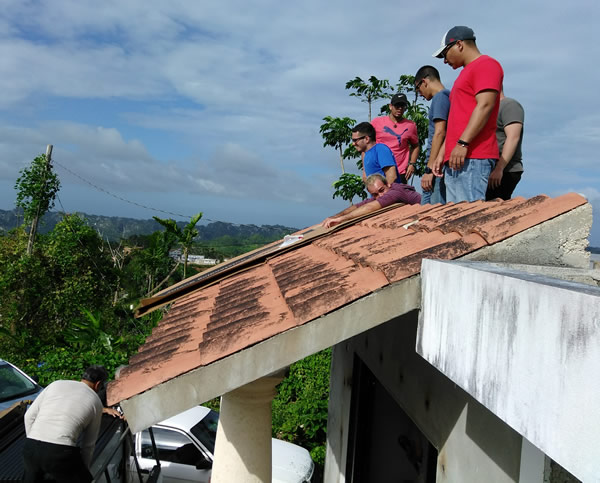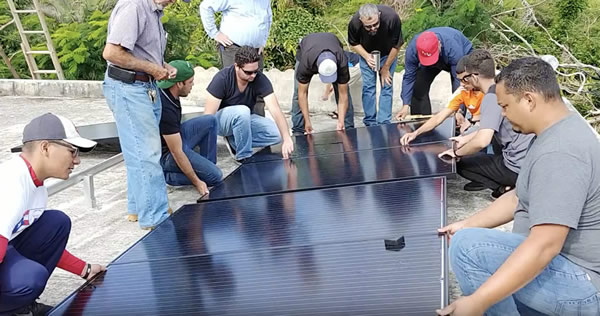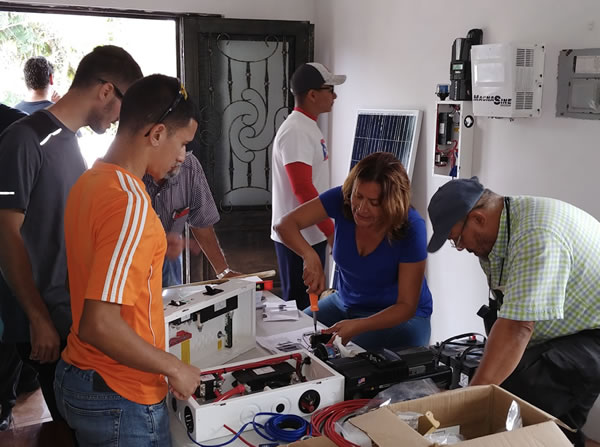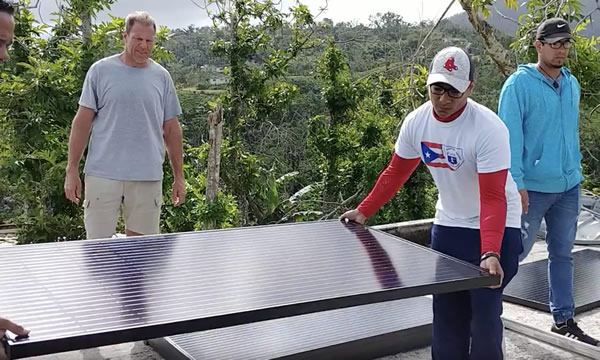
In late September of 2017, Hurricane Maria pummeled the island of Puerto Rico, ripping out its aging, indebted and poorly maintained electric grid by the roots. Island residents have struggled for months with unreliable electricity, and now some of them are turning to off-grid solar+storage systems to meet their needs.
At the time Maria arrived, Puerto Rica was already foundering from Hurricane Irma, which had clipped the island on September 8th, plunging a million people into darkness. Meteorologists marveled at the strength of Irma, declaring it the strongest recorded hurricane in the Atlantic, until Maria came along, just a few weeks later. Astounding scientists, the Caribbean community was bracing for two other threatening hurricanes on the very same day that Irma grazed Puerto Rico: Not far away, Hurricanes Katia and Jose were also gathering strength and threatening neighboring islands. But, ultimately, it was Maria that dealt the blow that Puerto Rico is still suffering from today, knocking down more than 80% of the island’s power lines, and plunging 95% of Puerto Rico’s electricity customers into darkness. Little did they know they would be without power indefinitely, and that living without electricity would become a way of life.
Eventually, the Army Corps of Engineers was brought in to manage an effort to help Puerto Rico rebuild its electric grid. Power was restored to 96% of the island’s customers. That restoration includes new poles, painstakingly delivered by helicopter to impossibly steep hillsides, new cabling and other infrastructure.
On the other hand, as what has always looked like a reluctant federal mission on the island winds down, approximately 30,000 residents are still in the dark, mostly in inaccessible mountain villages. Apparently they are losing hope of ever regaining power. And, just recently, more than six months after Hurricane Maria cut its destructive path across Puerto Rico, two massive blackouts occurred in April, affecting nearly a million people each time. In one case a single tree fell on a line, and another was caused by a construction incident. According to the Rhodium Group, an independent research firm, Puerto Rico customers have experienced power losses for a record 3.4 billion hours in the second longest blackout in history, worldwide,
The bottom line, according to experts who are helping Puerto Rico plan its energy future, is that the island’s restored power grid is not anything close to the modern, resilient grid that is needed to forestall future catastrophes.
Monster Caribbean Hurricanes: A “New Normal”
According to climate scientists, it’s likely that ever more powerful hurricanes will mark the future of the Caribbean, their fury fed by its rapidly warming waters. That means there’s a strong likelihood that these storms will continue to lash the island of Puerto Rico too, battering its electricity infrastructure, not to mention vulnerable housing built by a resourceful but predominantly low-income population. In order to survive, Puerto Rico must be resilient. But, what does that mean exactly, in terms of the electric power system? And, are the plans for Puerto Rico’s energy future headed in the right direction?

Utuado – A Remote Off-Grid Community Chooses to Produce Its Own Power
In light of the discouraging estimates for restoring power in mountainous regions, residents of rural Utuado have chosen to create a worker-owned cooperative Electricidad por el Pueblo (E-Pueblo for short) that will bring power to the region through the installation of off-grid residential systems consisting of solar and batteries. A spread out community of about 10,000 households, rural Utuado tends to have lower incomes relative to the average in Puerto Rico, and, as is the case all across the island, electricity costs are high. Most importantly, residents have been told that power in their area may not be restored for two years:
Utuado has several additional reasons for developing this cooperative off-grid project:
- Puerto Rican homeowners have been getting inflated quotes for individual solar systems – on the order of $45,000 per household.
- Average grid electricity prices in Puerto Rico are high at 16.74 cents/kWh.
- There is a supply shortage of renewable components and qualified installers, so waiting times are long.
- There is a lack of financing options so prospective owners must pay full upfront costs.
- Storage is essential for solar systems to generate without the grid and supply loads at night.
- Many solar suppliers are inexperienced when it comes to designing and installing reasonably-priced off-grid systems.

E-Pueblo offers three standard sizes of residential solar+storage systems. These systems will provide power over the next 20 years, with the choice to expand later. Dan Lepinski is a Fort Worth, TX engineer and solar designer who has been working with off-grid systems for decades. He created the E-Pueblo system designs pro-bono, incorporating his years of experience to make the systems robust, reliable, and affordable. Based on knowledge of the typical loads of the region gathered by Mason and Abreu, Dan chose an inverter size of 4.4 kW – large enough to power the majority of existing appliances in people’s homes. From there, he created the three system sizes to fit a variety of needs – all using the 4.4 kW inverter. Since the approach is to standardize everything to reduce error and installation time, the design will not be precisely optimized for each home but the cost savings more than make up for this.
Using HOMER Pro to Evaluate Economics of Solar+Storage Designs
To assess the economics of the system and determine what effect adding a generator has, Mason used HOMER ProⓇ to model the largest system on offer – 3 kW DC of PV and 10 kWh of batteries. Results show that although there is plenty of solar energy generated to satisfy the total energy needed for a typical residential load, the actual timing of use means that 25% of the time, the occupant may not have the energy available to use in the battery. This shortfall could be addressed in one of three ways – A) the occupant can simply pay attention and only use large amounts of electricity in the middle of the day, when the batteries are full; B) more batteries and solar panels could be added to the system; or C) a generator could be added to the system. It should also be noted that as more of the available solar energy is used, the lower the actual cost of energy (COE) will be. The following table of HOMER Pro results illustrates the tradeoffs between the three options:
Implementing Residential Solar+Storage in Remote, Tropical Communities
Meanwhile, Mason, Abreu, and a handful of local entrepreneurs are working on the financing and organizational aspects of the plan. They have already trained 15 locals to install the systems safely and correctly. The team believes that their strategy offers several advantages in the challenging Puerto Rican environment:
- Standard designs lower costs and promote consistency in installation.
- Mission Solar PV modules were chosen for their high efficiency and wind rating (175 mph).
- Crown sealed, lead acid batteries were chosen for their long track record, lower costs and easier maintenance.
- Energy efficiency upgrades – efficient refrigerators and LED lighting – will be offered in the same finance package.
- The systems are modular, designed to serve basic electric loads but allow easy expansion later if owners wish.
- Equipment suppliers are helping by providing bulk discounts from suppliers.
- Components are off-the-shelf and arrive in Puerto Rico within two weeks of order time, avoiding the current backlog that other projects face.
Lepinski says that every aspect of the system was carefully chosen to meet the particular situation of the Utuado community. Magnum PAE 4448 inverters are known for their reliability and ability to operate off-grid or used as an external generator (or the grid, if and when it is repaired in this area) to charge the batteries. He chose older lead acid battery technology rather than more powerful lithium ion batteries because of their flexibility: “If there’s ever a problem,” Lepinski says “they can just go get a car battery and plug it in. It will work the same way.” Puerto Rico’s hot, humid, environment is tough on batteries, and lead acid batteries are notoriously finicky to maintain. The specific brand of sealed batteries was also to chosen to survive over time without maintenance. Also, because the solar systems are standardized in three sizes, some of them might be slightly oversized. But, says Lepinski, that was intentional. “In case of emergencies, we wanted to be sure that people had enough power.”
E-Pueblo grew out of HOMER Energy’s early outreach effort to promote off-grid hybrid solar microgrids as the best solution to the widespread power outages in Puerto Rico. Alison Mason of SunJuice Solar in Fort Collins, CO, helped HOMER match donors and volunteers to organizations providing solar systems early on. Jose Abreu, a farmer from Utuado, reached out to Mason on behalf of his community and they have since been working to bring robust, low-cost, off-grid options to Utuado.

Communities Adapting to Off-Grid Life, and New Solar+Storage Energy Systems
Alison Mason, who is now fundraising for the project and organizing in the community, says that a vital key to success of the project is teaching the residents about solar energy. People may have to adjust their living habits somewhat to make use of their new, off-grid systems, and develop awareness of which activities are best carried out during the day when there are solar resources, and which ones at night, when battery power may be limited. She is helping train installers in the community and work with them to set up contracting businesses.
Mason says the off-grid systems she is designing will range in cost from $7,000 for the smallest, to $10,000 for the largest system, and they will be financed through a combination of loans and grants. Homeowners will be expected to contribute down payments of $700 – $1,000. Part of the savings is due to Lepinski’s work in negotiating volume/humanitarian discounts from equipment manufacturers.
E-Pueblo is still seeking grants and negotiating financing agreements but they hope to begin taking their first orders for systems this month. Meanwhile, Mason is hoping that the Utuado initiative can be replicated in other rural communities in Puerto Rico, even on other Caribbean islands that are still struggling to emerge from devastating hurricane damage. In Puerto Rico alone, there are about 30,000 households where stand-alone systems are an urgent priority.
If you would like to financially support E-Pueblo, you can make a tax-deductible donation by check (please email for details) or go to www.youcaring.com/escuelaantoniotullatorres-1183233 or www.youcaring.com/electricidadporelpueblo-1072878 to support specific programs.


Are US tax credits being utilized for financing? If properly utilized, then the home owners can end up paying less for self generated power compared to PREPA supplied power. With local organizing, such as what seems to have been accomplished here (an essential feature of such projects), then the whole island can be powered with solar, storage, diesel hybrids even if PREPA power has been restored. This type of project effort should continue
Hello Anand.
Thank you for your comment. Yes, the tax credits do figure into the financing in this situation. Let’s hope they succeed and that the concept can benefit Puerto Rico beyond this specific community.